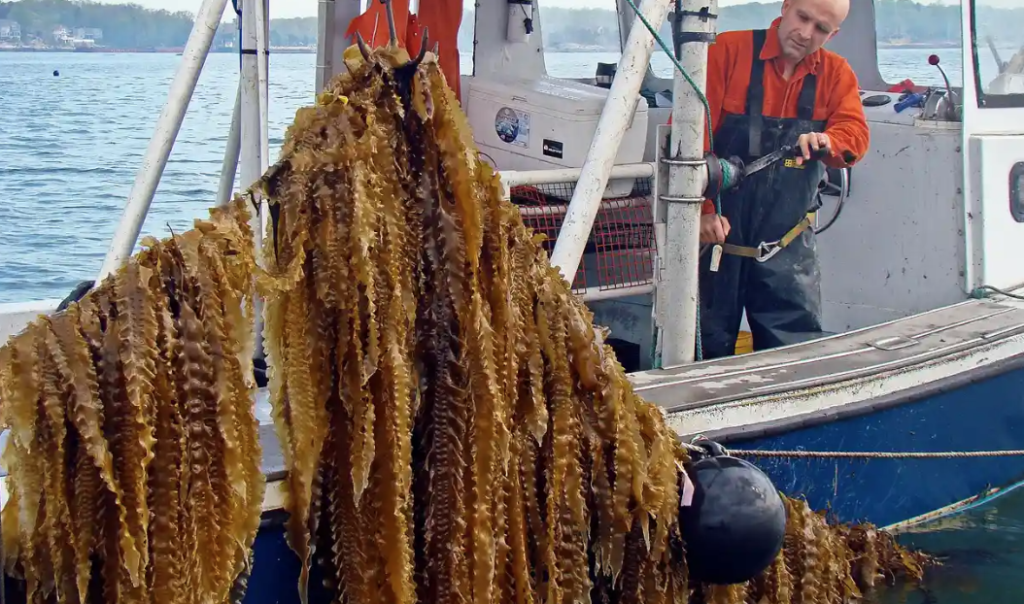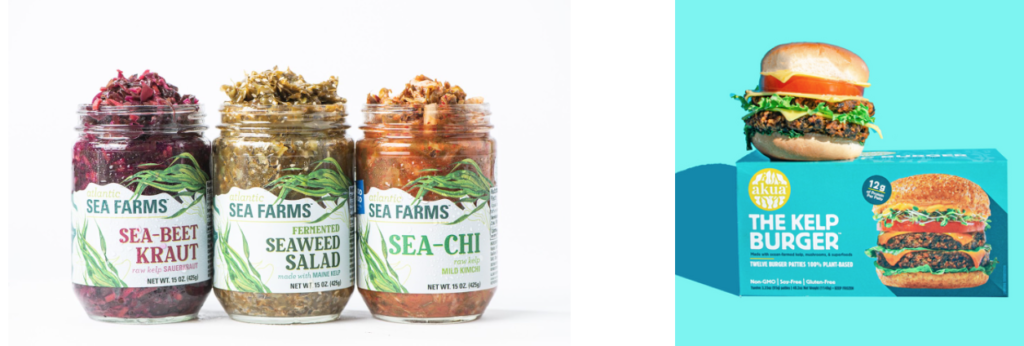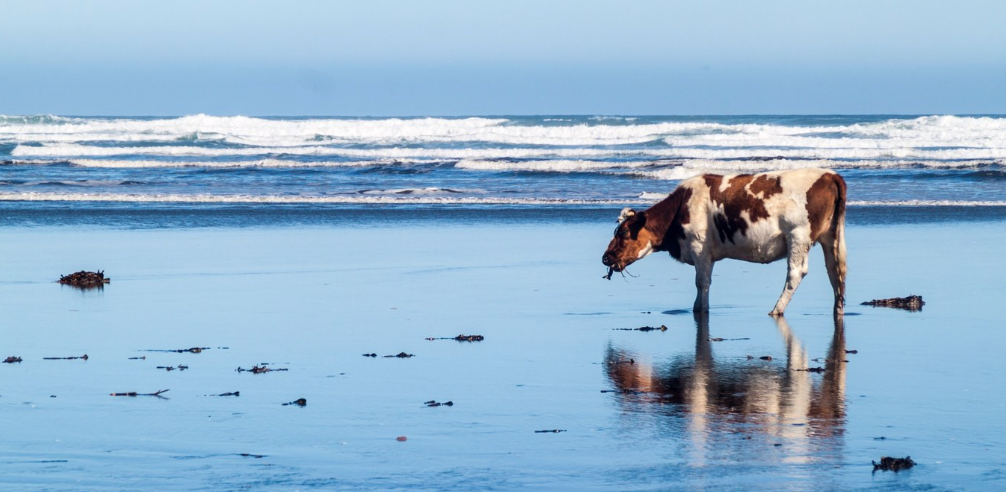It is soothing to watch ocean waves lap the shoreline of Machiasport–a sleepy coastal town of less than 1,000 people, situated in Downeast Maine. If you look beyond the jagged coastline, vibrant buoys bob in synchrony, unsuspiciously supporting a sea crop that flourishes just feet below the surface: kelp. This particular ocean farm belongs to Morgan-Lea Fogg, a Machiasport native who is now the resident farmer and Director of Impact & Special Projects for AKUA, a kelp foods company founded in 2019. A variety of similar enterprises have sprung up in recent years as U.S.-grown seaweed has taken a front seat in aquaculture ventures. In Maine alone, farmed seaweed harvests grew from 15,000 pounds in 2015 to over 325,000 pounds in 2019 (Piconi et al., 2020). To support this industry, companies such as AKUA are hatching innovative ways to normalize this nutritious, environmentally-restorative sea vegetable.

Ron Gautreau, Greenwave
How Kelp Can Help
Ocean-based kelp farming has emerged as not only one of the most sustainable methods of aquaculture, but an actively restorative one. Contrary to its land-dwelling relatives, kelp requires no freshwater, no pesticides, and no arable land to flourish (Johnson and Maher-Johnson, 2018). This maintenance-free system actively protects the surrounding ecosystem from the hazards of ocean acidification (OA) by soaking up dissolved carbon dioxide for use in photosynthesis, thereby restoring pH to healthy levels (Arnold, 2018). Kelp can also help to prevent harmful algal blooms (HABs) by absorbing anthropogenic inputs of nitrogen and phosphorus–nutrients that stimulate the toxic proliferation of algae–to feed itself (Johnson and Maher-Johnson, 2018).
U.S. investment in this method of regenerative ocean farming (ROF) has grown substantially in the past decade as people have sought to supplant the tradition of purchasing seaweed products from China and Indonesia. With imports accounting for over 95% of edible seaweed products available in the U.S., there is plenty of room for homegrown farmers to take over (Piconi et al., 2020). Such a switch would also eliminate the monetary and emissions costs of cross-continent transportation. Farmers such as Fogg are therefore “[creating] nutritious, delicious kelp-based products that support ocean farmers and fight climate change” (“Expanded Product,” n.d.).
Currently, Maine and Alaska are farming the majority of domestic seaweed biomass, but ROF is quickly expanding throughout New England and the West Coast. Researchers project U.S.-farmed seaweed harvests will quadruple by 2035 (Piconi et al., 2020). Expansion of the kelp farming industry creates and diversifies coastal jobs, provides healthy seafood from local sources, and buffers marine wildlife from the impacts of OA and HABs. So, what’s left to do? Sell this seaweed all along the seashore.
Taking Our Taste Buds Out to Sea
Finally growing out of the boutique, US-grown seaweed market in 2019, kelp has begun to make a new name for itself by flaunting its applicability and nutrition (“Expanded Product,” n.d.). Kelp is a versatile food that can be kept fresh, frozen, dried, or ground into an array of products, from noodles to seasoning (Yu, 2019). This salty sea veggie is packed with potassium, magnesium, fiber, essential fatty acids (omega-3’s), high quality proteins, and vitamins A, B, C, E, and K (“Nutrient Information,” n.d.). A single ⅓ cup serving of kelp can satisfy your daily iodine requirements–a mineral that is essential for regulating metabolism, among other important bodily processes.
The U.S. non-profit Greenwave is leading the charge to get more ROF operations up and running, and is now directing a market innovation program that helps open up new business channels for these ROF farmers. AKUA is just one of the companies that Greenwave is partnering with to develop desirable kelp commodities. Courtney Boyd Myers–the co-founder of AKUA–launched her first product, kelp jerky, back in 2019 upon learning about the vast environmental, economic, and health benefits of kelp farming. Their new headline product is the world’s first commercially sold kelp burger; this is what propelled the company to the national stage. Since their initial launch, AKUA has tripled their purchasing volume and garnered more capacity for food research and development, adding pasta, ground “meat,” and a kelp “krab” cake to their list of creations (“Expanded Product,” n.d.). “We’re on a mission to make kelp mainstream,” says Boyd Myers.

Atlantic Sea Farms / AKUA
And they’re not alone. Back in Maine, Atlantic Sea Farms (ASF) is making waves with their award-winning kelp-based kimchi, fresh seaweed salad, and smoothie-ready frozen kelp cubes. ASF even boasts high-profile partners such as Sweetgreen and Daily Harvest. Alaska’s Barnacle Foods is creating a line of salsa made from bull kelp that packs an umami punch. Eat More Kelp (Long Island, NY), Seagrove Kelp Co. (Alaska), and Blue Evolution (Pacific Coast) are also hopping on the regenerative seaweed farming boat. With >80% of domestic seaweed production growth through 2035 projected to be stimulated by value-added edible products, the only thing left to do is get this kelp on your shelf (Piconi et al., 2020).
Kelp Can “Usurp the Burp”
The benefits of kelp are being explored beyond the human market, creating an even larger demand for biomass. One surprising candidate: cows. There are about 3 billion ruminant animals on the planet–including cows, sheep and goats–that burp methane as part of their digestive process (“Greener Grazing,” n.d). Methane has almost 30 times the short-term heat trapping power as carbon dioxide, making it an especially potent greenhouse gas. According to the EPA, domestic livestock in the U.S. contribute 36% of anthropogenic emissions, and in California alone, 1.8 million dairy cows emit as much CO2 equivalent as 2.5 million cars each year (Battaglia, 2016). In some environmentalists’ perfect world, the entire planet would be vegan. However, this tactic ignores the 1.3 billion people that partially or entirely depend on the livestock industry as a vital source of income (Battaglia, 2016).
Through kelp driven innovation, perhaps we don’t have to condemn livestock production outright. Researchers at James Cook University in Australia explored the ancient Greek and Icelandic practice of raising cattle by the ocean to tackle this conundrum (Yu, 2019). The team tested out over 20 species of seaweed in cow’s diets and came up with one clear climate-friendly winner: Asparagopsis taxiformis. Whereas some species reduced methane emissions by 50% when comprising up to 20% of the feed, A. taxiformis reduced methane production by 99% when only taking up 2% of the diet (Kinley et al., 2016). Kinley and his team realized that bromoform–a molecule found in A. taxiformis–disrupts an enzyme used by a methane-producing gut bacteria in the course of digestion. In addition to solving an environmental problem, seaweed feeds also help farmers save on cattle cuisine: by minimizing energy waste in animal digestion (~15% of feed expenses are lost in methane emissions) the livestock can grow and produce more milk while requiring less sustenance (Battaglia, 2016).

Shutterstock
Many growers and foodies projected that kelp will take over as “the new kale” and come to dominate the plates of health-minded consumers (Yu, 2019). Despite this enthusiasm, kelp still needs all (I’m looking at you, cows) of our curiosity and support to reach an economy of scale in which such nutrient-rich, climate-friendly creations can compete with other GMO, lab-grown, and resource-intensive food alternatives on the market today. The bottom line, says Myers: “If we can move people’s stomachs, we can move their minds to be conscious of the impact of their decisions around food and in other parts of their life.” The next time you visit the grocery store, go out to eat, or talk to a friend, try to make a choice that will actively kelp our farmers, our seas, and our planet.
References
Arnold, S. (2018, October 26). When kelp met mussel…—Island Institute. https://www.islandinstitute.org/working-waterfront/when-kelp-met-mussel/
Battaglia, M. (2016, October 12). Seaweed could hold the key to cutting methane emissions from cow burps. The Conversation. Retrieved March 30, 2022, from http://theconversation.com/seaweed-could-hold-the-key-to-cutting-methane-emissions-from-cow-burps-66498
Expanded Product Lines Push Kelp to Center of the Plate. (n.d.). GreenWave. Retrieved March 30, 2022, from https://www.greenwave.org/blog-who-farms-matters/cbm
Greener Grazing: A Seaweed Solution to Reduce Methane Emissions from Livestock on Vimeo. (n.d.). Retrieved March 30, 2022, from https://vimeo.com/280576901?embedded=true&source=vimeo_logo&owner=87440082
Johnson, A. E., Maher-Johnson, L.E. (2018, November 2). Soil and Seaweed: Farming Our Way to a Climate Solution. Scientific American Blog Network. https://blogs.scientificamerican.com/observations/soil-and-seaweed-farming-our-way-to-a-climate-solution/
Kinley, R. D., Nys, R. de, Vucko, M. J., Machado, L., Tomkins, N. W., Kinley, R. D., Nys, R. de, Vucko, M. J., Machado, L., & Tomkins, N. W. (2016). The red macroalgae Asparagopsis taxiformis is a potent natural antimethanogenic that reduces methane production during in vitro fermentation with rumen fluid. Animal Production Science, 56(3), 282–289. https://doi.org/10.1071/AN15576
Mernit, J. (2018, July 2). How Eating Seaweed Can Help Cows to Belch Less Methane. Yale E360. https://e360.yale.edu/features/how-eating-seaweed-can-help-cows-to-belch-less-methane
Nutrition Information | Maine Seaweed Council. (n.d.). Retrieved March 30, 2022, from https://www.seaweedcouncil.org/nutrition-information/
Piconi, P., Veidenheimer, R., & Chase, B. (2020). Edible Seaweed Market Analysis. Island Institute. http://www.islandinstitute.org/edible-seaweed-market-analysis-2020
Selinger, H. (2021, January 16). Why Isn’t Kelp Catching On? The New York Times. https://www.nytimes.com/2021/01/16/style/self-care/why-isnt-kelp-catching-on.html
Yu, A. (2019, June 3). Kelp Has Been Touted as the New Kale, But it Has Been Slow to Catch On. NPR. https://www.npr.org/sections/thesalt/2019/06/03/725790613/kelp-has-been-touted-as-the-new-kale-but-its-been-slow-to-catch-on